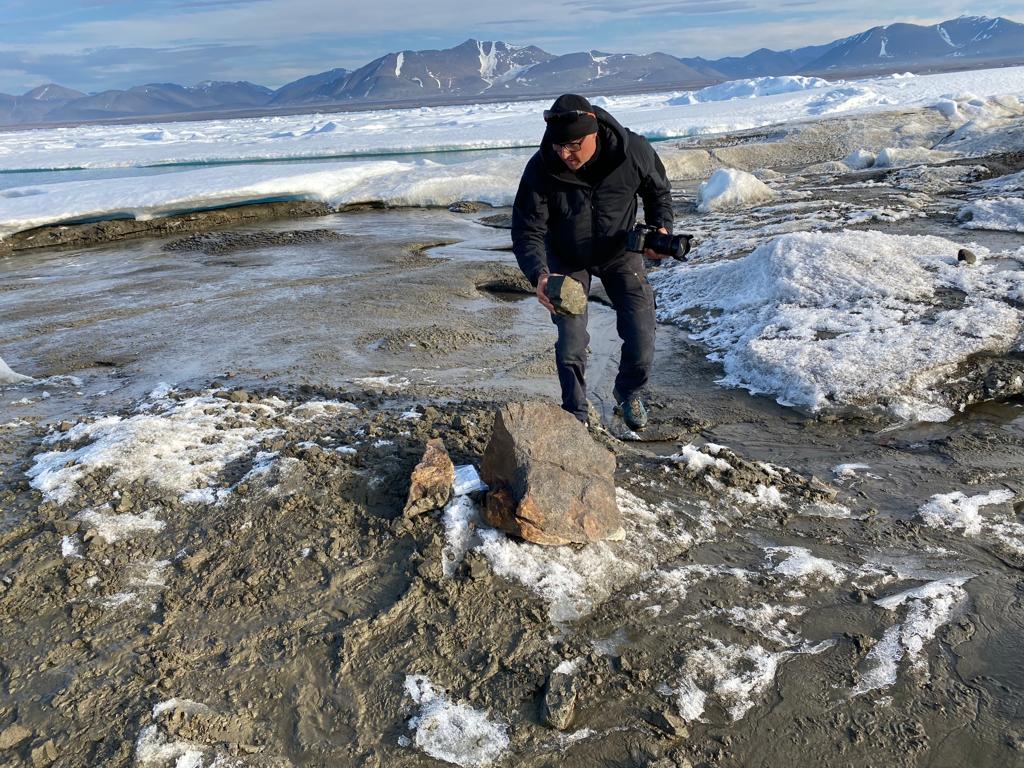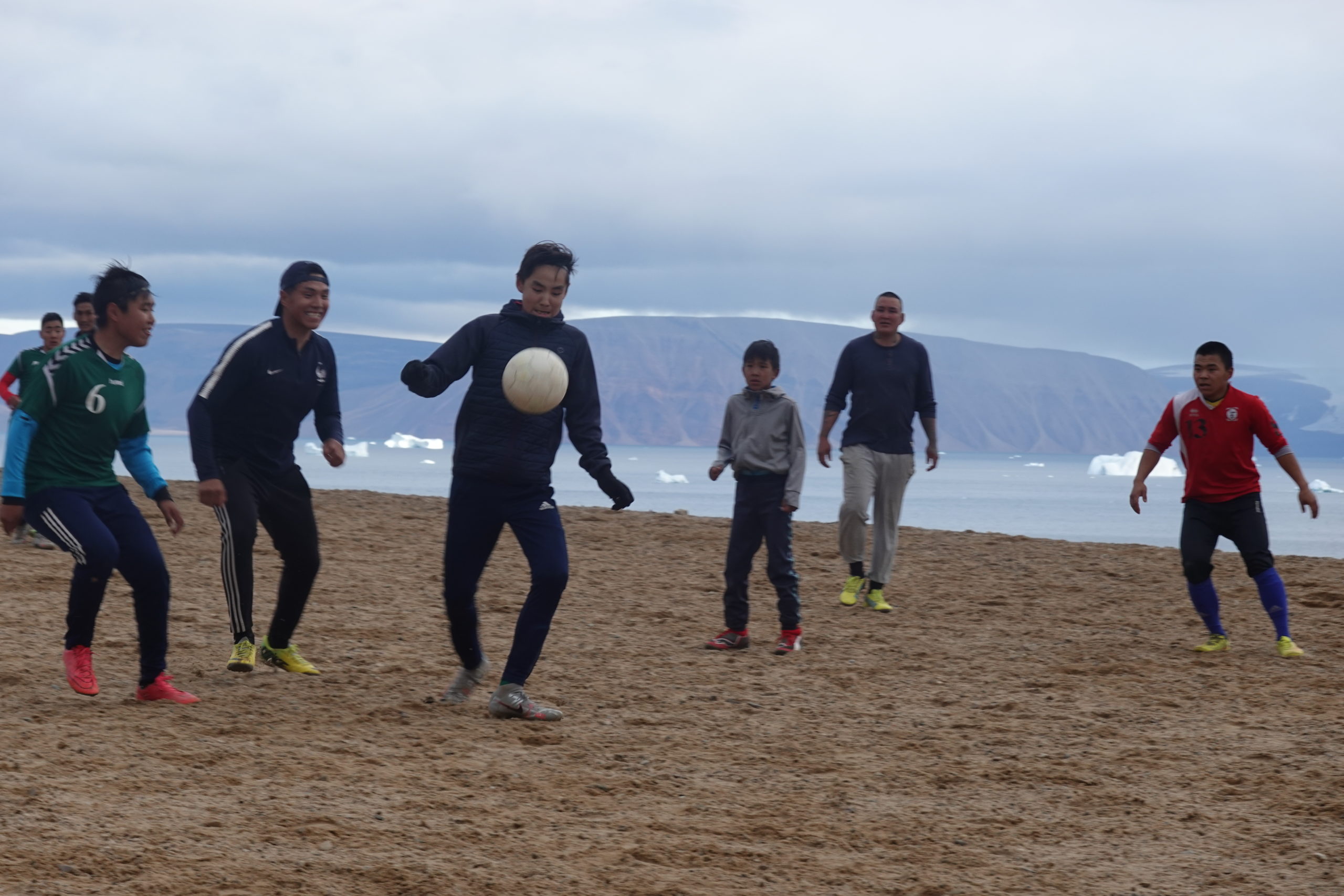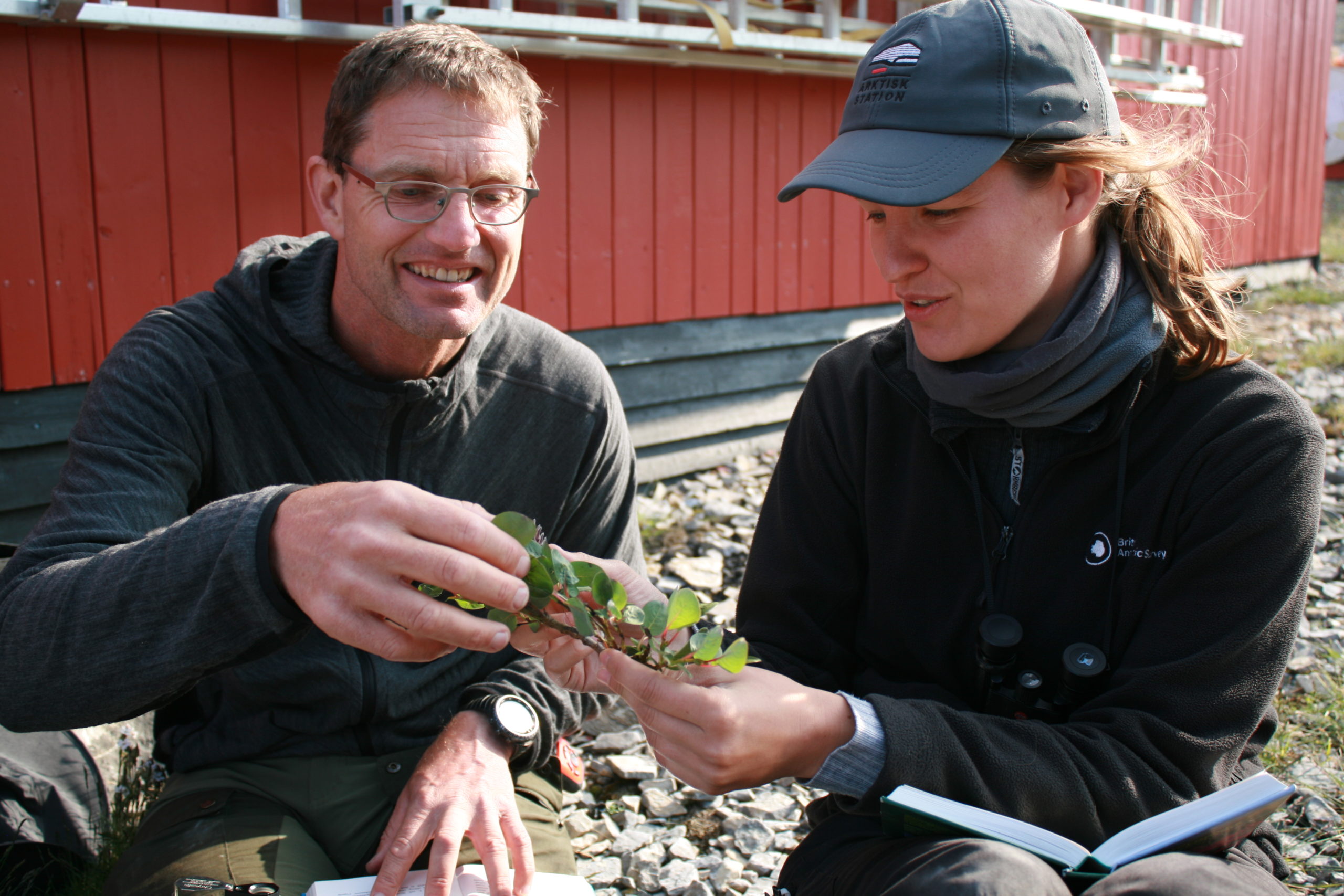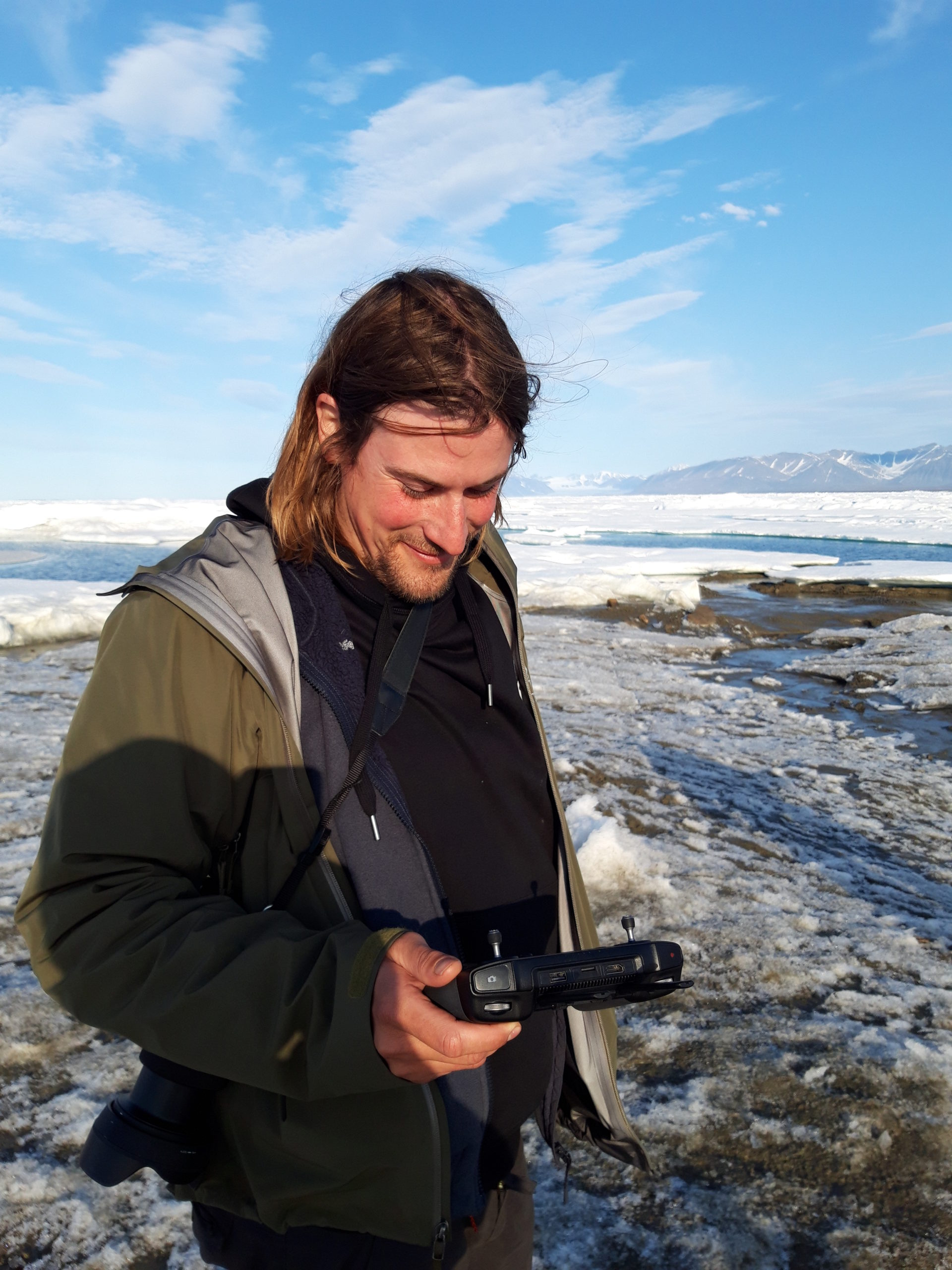What we can learn from a visit to the world’s northernmost island
An expedition of scientists and artists visits Oodaaq Island, off Greenland's northern coast.

Several days ago, I was fortunate enough to visit the northernmost island in the world when a small helicopter from the expedition I was travelling with touched down on Oodaaq Island in the shallow waters some two kilometers north of Greenland.
Oodaaq Island is situated a bit further north than Cape Morris Jesup, the northernmost tip of Greenland, which lies some 710 kilometers from the North Pole.
It was close to midnight, a bright polar sun was shining and we had basically no wind. Oodaaq Island is a small knot of sea ice, snow patches, fine-grained mud and a handful of small pyramids of more substantial gravel. The island was just big enough for our helicopter and our group of five who now enjoyed a much-appreciated opportunity to celebrate our arrival with a brief swim in the shallows. It was truly a unique moment and a strong reminder of Greenland’s very special position on the world map and in everything from Arctic security to the study of climate change.
After its discovery in 1978, Oodaaq Island was named after one of the intrepid but often forgotten sled masters from Greenland’s Thule district who facilitated the early mapping and exploring of North Greenland by Robert Peary, Lauge Koch, Knud Rasmussen and others.
A handful of expeditions have visited Oodaaq Island since its discovery, others have sought it in vain. Several smaller islets have been registered elsewhere in the shallows, some or all of which have disappeared again. When we were there last week, one of my travel-companions, Morten Rasch, who is a coastal geomorphologist and the scientific leader of Arktisk Station in Qeqertarsuaq, the oldest research station in Greenland, explained to me that Oodaaq Island is scientifically speaking probably not a real island.
The gravel at Oodaaq Island, he said, is old moraine or glacial till, a continuation of the flat coastal plains of north Greenland, washed over by the ocean after the last ice age and later bulldozed by roving sea ice into the cone shaped piles we saw just above the surface — nobody knows when. It follows that Oodaaq Island could possibly soon dissipate again into the ocean at the whim of the sea ice, winds and currents. But I doubt very much that this transience will diminish the lure of the island.
The study of life
Our visit was part of a Swiss-Danish science expedition, the Leister Expedition Around North Greenland 2021. Several of the participating scientists are engaged in the study of how life — vascular plants, microbes, mosses and lichen — could evolve and move still further north and still higher up north Greenland’s rocky mountain slopes as climate change accelerates.
The Swiss and Danish scientists including climate researchers from the Center for Permafrost at the University of Copenhagen collected samples and new data, for instance from Kap København, a cape in the eastern parts of north Greenland that might never have been covered by ice, and from an ongoing research project focused on permafrost further to the west.
Oodaaq Island was on the agenda primarily as an add-on, but we did collect samples of mud and gravel for later scientific analysis. Perhaps bacteria that do not belong to the marine environment have settled here; perhaps Oodaaq Island is indeed a real island; we’ll know in a few months. (For more about the islets north of Greenland I highly recommend Ole Bennike’s and Jess Shea’s January 2019 presentation in Polar Record.)
Where is the ice?
At Kaffeklubben Island about a kilometer closer to shore we found several examples of the small yellow Arctic poppy, purple saxifrage, mosses and lichen. Kaffeklubben Island is a real island, reaching some 30 meters above the sea, smoothed like a bald man’s head by the winds and the ice. The frost patterns in the rocky surface show that the island has been here for perhaps thousands of years.
From the top of Kaffeklubben (literally “the coffee club” in Danish) we saw plenty of open water to the north in the Arctic Ocean. Likewise, in the days prior as we flew across Peary Land from the south towards our camp in Citronen Fjord, we noticed plenty of open water along the northern coast of Greenland. The sea ice in this part of the Arctic Ocean is known to be the thickest multi-year sea ice in the entire Arctic. The scientists reckon that this part of the ocean will be the last to lose its summer ice to the rising temperatures. But perhaps it is already affected.
We made sightings of such possible effects of climate change all along our route from Ittoqqortoormiit on Greenland’s east coast to Qaanaaq in the west, Greenland’s northernmost town. During a night in tents in Cass Fjord several hours of flight north of Qaanaaq one of our expedition members had to abandon his tent and sleep in the open — it was that warm.

In Qaanaaq, as we regained faster access to the web, we learned that the temperatures had reached 19.8 degrees Celsius in that region just when we were there — the highest ever recorded — and the Greenland ice sheet underwent one of its largest melting events ever.
“We had these sorts of atmospheric events in the past but they are now getting longer and more frequent,” Marco Tedesco, a glacier expert at Columbia University and adjunct scientist at NASA, had told The Guardian.
Tough plants
I was glad to be travelling with people who could add scientific perspectives and creative thinking not only to these disturbing signs of very rapid climate change but also to the multitude of majestic natural wonders on our route.
One of these was Elise Biersma, a 32-year-old evolutionary biologist and post-doctoral fellow at the Natural History Museum of Denmark and the British Antarctic Survey in Cambridge. She presently researches the age and origin of Greenlandic flora — vascular plants, mosses, lichens — in order to understand their evolutionary processes and how they may respond to future climate change.
“Life at these high latitudes is really fascinating: In the Antarctic I have been studying the origin of plants, using genetics. Some endemic species revealed they had survived there on multi-million-year timescales under very harsh conditions,” she told me. Now she investigates similar patterns on plants in Greenland too.

Some of the vascular plants, mosses and lichen in north Greenland are among the toughest in the Arctic, but their evolutionary history, their ability to cope with the rough climatic conditions —in particular drought — and their biogeographic origin have so far only been rudimentarily mapped.
“Greenland is home to several endemic species, which, given the short timescale since the last glaciation, is quite fascinating.” she said.
“It is likely that several of these species evolved from recent hybridization events or similar evolutionary processes (originating from two different parent species or a doubling of genetic material within one individual), which can lead to new species,” she said.
“These rapid evolutionary processes are captivating. There is a lot of focus on the extinction of species in the Arctic, but less on the development of new species on short timescales,” Biersma said. “This could be a process for some organisms to quickly adapt to future climate change.”
She was happy that she will eventually add her findings to the larger global collection of biological knowledge and to ongoing climate studies — and happy for simply being so far north:
“I can’t get enough of the landscapes, the silvery light, the little beautiful plants and flowers that grow here, even if the season is so short. And the birds! Did you see the long-tailed skua just now? The days are longer here and you have more energy, as if time has a different dimension. It is really not our habitat; I feel very privileged to be here,” she said.
Re-learning to see
Another member of our group, Swiss-French Julian Charrière, 33, has won international recognition as a conceptual artist particularly through his intricate study of our relation with the natural world. He has explored and collected material from a number of remote locations, including Pacific islands, radioactive sites and the subsea. In 2013, he climbed an impressively tall iceberg off Iceland armed with a large industrial blowtorch and enough propane for eight hours of burn. This performance is captured in his photographic series The Blue Fossil Entropic Stories. His artwork has been exhibited across much of the world, including at the first (and so far last) Antarctic Biennale in 2017 and he has been preoccupied with the Arctic since a visit to Iceland in 2011:
“The landscape there triggered something. It confused me and my way of perceiving the world. You kind of lose your sense of scale and orientation in the Arctic. You don’t have a horizon with a tree, a person or a house that you can relate to and use to create your three-dimensional space to work and move in. In the Arctic you have to re-learn to move and re-learn to see,” he said.

He is keen to examine the mainstream western collective imagery of the Arctic, often saturated as it is with old stories of famous explorers and others from the south who claimed to have discovered the Arctic:
“There are all these local cultures and peoples in the Arctic who have dreamed their place, who have built their place with all their own stories and traditions, and then there is this western-oriented science vision of the Arctic which is coping with that and maybe even moving over it and drowning it,” he said.
It was Charrière who moved out of his tent in Cass Fjord because of the high temperatures in north Greenland, and he linked this unexpected experience directly to climate change:
“I never thought I would be sleeping outside my sleeping bag in 20 degrees Celsius at midnight at 82.4 degrees north,” he said.
“The changes here are happening so fast that we are not able to adapt our world vision, our collective idea of what this place should be and ought to look like, with the same speed that the landscape is changing with,” he said. “There is a gap, like a crevasse, and it is getting bigger and bigger. We are somewhat disconnected from reality, so it is really important for me as an artist to come here and see these processes that will happen everywhere but are happening here in a much faster way. The polar regions are our magnifying glass that allows us to see into the future.”
CORRECTION: An earlier version of this story included a caption that erroneously described an expedition member as taking samples, rather than constructing a cairn. The caption has been updated to provide a more accurate description.
The Leister Expedition Around North Greenland 2021 travelled in Greenland from July 18-30. Martin Breum is a Danish author and journalist based in Copenhagen and a regular contributor and columnist with ArcticToday.